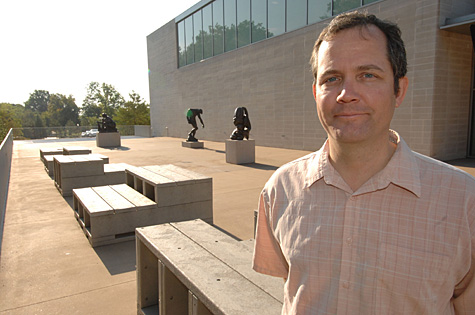
Public art is a tricky beast. Sometimes you get the Gateway Arch or Citygarden or Laumeier Sculpture Park. Sometimes you don’t.
The key is integration, says Leslie Markle, who recently joined the Mildred Lane Kemper Art Museum as its inaugural curator for public art. Among other duties, Markle will oversee Washington University’s new Art on Campus policy, which dedicates 1 percent of major construction and renovation budgets to commissioning contemporary site-specific artworks.
We sat down in his office:
Tell us about your background.
I was born in Poughkeepsie, NY, but grew up in Southern California. I studied art at California State University at Long Beach. I also apprenticed with a furniture maker and for a number of years designed and built furniture, as well as portable architecture and installations.
I’ve been involved with public art for about 20 years, first as an artist’s assistant, then as part of a design team. In 2007, I moved over to the administrative side, directing the public art program for the City of Long Beach.
What’s the biggest misconception about public art?
People think you just pick things out of a catalog — the “plop-art” idea. But today, if you’re still thinking in terms of a stand-alone object, you’re probably wasting your money. It’s much more valuable, and more cost-effective, to integrate art into the architecture or infrastructure.
So what does a good project bring to the table?
I think good public art adds a level of attention and detail that contributes to the social and cultural environment. It takes a space and transforms it into a real gathering spot. In Long Beach, a lot of the projects we did — such as the A LOT Series, which created temporary works in vacant lots — grew out of redevelopment efforts. The idea was to create a more livable place.
What artists or projects do you particularly admire?
Someone who really impacted my thinking, many years ago, was Robert Irwin, who was actually born in Long Beach. His idea is that public art should be integrated with — and complement — its surrounding. The Getty Central Garden, which Irwin designed, is one of Los Angeles’ great public spaces, but a casual visitor might not realize that an artist was involved at all.
Another great example is Spine, the art component for the Los Angeles Central Public Library. It was a collaboration between the artist Jud Fine and the landscape architect Lawrence Halprin. The artwork is woven into the landscape design.
When doesn’t public art work?
When it’s an afterthought.
So what’s on the drawing board?
Right now, we have a couple of smaller projects related to the renovations of Umrath Hall and Cupples II. There is also a proposal under way for the Olin Business School expansion.
I think the new student apartments in the Delmar Loop will be our first opportunity to identify the artist early on, and to put them in dialogue with the architects prior to construction.
How does the selection process work?
The process for public art is derived from architecture and urban planning. First, you visit the site and inventory the current conditions — physical conditions as well as social and cultural conditions. The idea is to create a context and a profile that will help identify art opportunities.
For each project, we’ll then develop a pool of three to five artists and invite them to be considered. I’ll then make a presentation to the selection committee, which will choose one artist for a site visit. That artist will then generate a formal proposal, which the committee will vote to select or to not select.
What are the criteria for selection?
Artworks commissioned by Art on Campus will be accessioned by the Kemper Art Museum, so they will be cared for with the same museum and professional standards. They also must be durable enough to withstand everyday wear and tear due to exposure and the elements, an unsecured environment, or other unique conditions.
More broadly, they should reflect the university’s stature, mission and the diversity of its people and intellectual activity.
Any final thoughts?
Usually, you’re looking at a pool of artists who are all of pretty high caliber. Any one of them could probably do a very good project.
It’s really just a question of what’s most appropriate for the space.